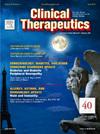Effect of Intravenous Immunoglobulin or Plasmapheresis in Myasthenic Crisis and Worsening Myasthenia Gravis Compared to Without Rescue Treatment
IF 3.6
4区 医学
Q2 PHARMACOLOGY & PHARMACY
引用次数: 0
Abstract
Purpose
There is a paucity of studies on intravenous immunoglobulin (IVIg)/plasmapheresis (PLEX) compared with no rescue treatment (NRT) in myasthenic crisis (MC) and worsening myasthenia gravis (WMG). We report the efficacy of RTs (IVIg and PLEX) compared with NRT in MC/WMG.
Methods
Patients with MC and those having worsening in the MG Foundation of America classification by ≥2 grades were included. Their clinical findings, precipitating causes, and MG Activity of Daily Living (MGADL) and MG Quality of Life (MGQoL)-15 scores were noted. Patients were either treated with IVIg (400 mg/kg/d for 5 days) or PLEX (20–25 mL/kg × 5 sessions), and nonaffording patients received only standard care. The primary outcome was improvement in MG Foundation of America classification by ≥2 grades, and the secondary outcomes included MG Activity of Daily Living score, MG Quality of Life-15 score, Myasthenia Muscle Score, and days of mechanical ventilation (MV), hospital stay, and reaching pre-worsening status at 1 month.
Findings
Forty-four patients were included; 19 had MC and 25 had WMG. They were treated for MG for 2 to 19 years. Forty-one (93.2%) patients achieved the primary end point; 22 (95.7%) in RT and 19 (90.5%) in NRT (P = 0.60). The overall odds ratio of RT for the primary outcome was 1.20 (95% CI, 0.70–23.50; P = 0.13). The RT group had an overall hazard ratio of 0.93 (95% CI, 0.37–2.40; P = 0.96) for duration of MV, had hospital stay of 0.78 days (95% CI, 0.34–1.94; P = 0.80), and achieved pre-worsening MG status in 0.99 days (95% CI, 0.40–2.40; P = 0.72) compared with NRT after adjusting for age, triggers, dose of acetylcholine esterase inhibitors (AChEIs), and azathioprine at baseline. PLEX had an edge over IVIg in reducing the duration of MV and hospital stay, but overall hazard ratio was not significant. The RT group, however, required a lower dose of AChEIs (P = 0.04). Ten patients had mild adverse effects.
Implications
All the patients with MC and WMG improved irrespective of RT or NRT, and the RT group required a lower dose of AChEIs at 1 month. A multicenter randomized controlled trial may confirm these observations.
静脉注射免疫球蛋白或血浆置换治疗重症肌无力危象和加重重症肌无力的疗效比较。
目的:在重症肌无力危象(MC)和加重的重症肌无力(WMG)中,静脉注射免疫球蛋白(IVIg)/血浆置换(PLEX)与无抢救治疗(NRT)的比较研究较少。我们报告了RTs (IVIg和PLEX)与NRT在MC/WMG中的疗效。方法:纳入MC患者和美国MG基金会分级≥2级加重患者。记录他们的临床表现、诱发原因、MG日常生活活动(MGADL)和MG生活质量(MGQoL)-15评分。患者接受IVIg (400 mg/kg/d,连续5天)或PLEX (20-25 mL/kg × 5次)治疗,而负担不起的患者只接受标准治疗。主要预后指标为MG美国基金会分级改善≥2级,次要预后指标为MG日常生活活动评分、MG生活质量评分、重症肌无力评分、机械通气天数(MV)、住院时间、1个月达到恶化前状态。结果:纳入44例患者;MC 19例,WMG 25例。他们接受了2至19年的MG治疗。41例(93.2%)患者达到了主要终点;RT组22例(95.7%),NRT组19例(90.5%)(P = 0.60)。主要结局RT的总优势比为1.20 (95% CI, 0.70-23.50;P = 0.13)。RT组的总风险比为0.93 (95% CI, 0.37-2.40;P = 0.96),住院时间为0.78天(95% CI, 0.34-1.94;P = 0.80),并在0.99天内达到MG恶化前状态(95% CI, 0.40-2.40;P = 0.72)在调整年龄、触发因素、乙酰胆碱酯酶抑制剂(AChEIs)剂量和氮唑嘌呤基线后与NRT进行比较。PLEX在缩短MV时间和住院时间方面优于IVIg,但总体风险比不显著。然而,RT组所需的AChEIs剂量较低(P = 0.04)。10例患者出现轻度不良反应。意义:所有MC和WMG患者不论RT或NRT均有改善,RT组在1个月时需要较低剂量的AChEIs。多中心随机对照试验可以证实这些观察结果。
本文章由计算机程序翻译,如有差异,请以英文原文为准。
求助全文
约1分钟内获得全文
求助全文
来源期刊

Clinical therapeutics
医学-药学
CiteScore
6.00
自引率
3.10%
发文量
154
审稿时长
9 weeks
期刊介绍:
Clinical Therapeutics provides peer-reviewed, rapid publication of recent developments in drug and other therapies as well as in diagnostics, pharmacoeconomics, health policy, treatment outcomes, and innovations in drug and biologics research. In addition Clinical Therapeutics features updates on specific topics collated by expert Topic Editors. Clinical Therapeutics is read by a large international audience of scientists and clinicians in a variety of research, academic, and clinical practice settings. Articles are indexed by all major biomedical abstracting databases.
 求助内容:
求助内容: 应助结果提醒方式:
应助结果提醒方式:


